Will Wi-Fi work at a speed of 340 km / h?
During the summer internship, I was asked to find out if the wireless connection would work if the receiver was moving fast relative to the transmitter. In this article I will talk about the Doppler effect and how terrible it is; what the Wi-Fi device needs to not be afraid of it, and also share the results of an experiment in which we reached a speed of 340 kilometers per hour!

My name is Ilya Shukhman, and more recently I was a student at the Ural Federal University of the Institute of Radio Electronics and Information Technology (IRIT-RTF). My specialization - on papers radio engineer, in fact - there was a bit of STM-32 programming, there was project planning, there was also a radio communication system simulation, I was interested in Cisco equipment. After the end of training days, I went to practice at InfiNet Wireless.
I was instructed to prepare an experiment that would dispel doubts about the possibility of using this company's radio equipment on links, where the subscriber is moving relative to the base station at high speed. For example, if it is attached to the Sapsan locomotive. One of the threats in this case is the Doppler effect, in which the frequency of the wave changes with the relative movement of the transmitter and receiver.
What is the nature of this effect? Imagine that you were given a roll of paper and charged to draw a sine wave on it. You started the task responsibly, but in the process, the paper on which you are drawing began to move with some speed. Obviously, if you pretend like nothing happened, the wavelength in your pattern will increase, and the frequency will decrease. This effect is called the Doppler frequency shift.
In a narrowband signal, the Doppler shift is represented by the following formula [1]:
Where - carrier frequency signal - relative speed of movement, - the speed of light.
For example, let's take parameters close to our equipment and condition of the problem: speed - 300 km / h, carrier frequency - 5.3 GHz, speed of light - as always 3 * 10 ^ 8 m / s.
Calculate:
For data transmission to the radio, QAM modulation can be used, in which information is encoded on the basis of constellations. The more points in the constellation, the higher the bandwidth of the radio channel. In Matlab, we model the usual transmission over the radio path, using the Rice channel as a model:
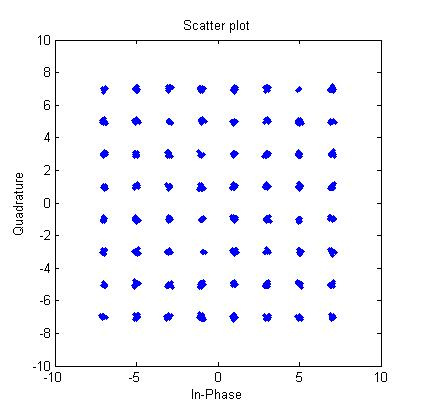
Let me remind you that each cluster of points corresponds to one byte. Yes, the points have a little spread, but within the limits of decency, and the receiver can still unequivocally understand which byte each point corresponds to. Now let's add the Doppler shift at a speed of 30 km / h:

At 70 km / h:

At 100 km / h:
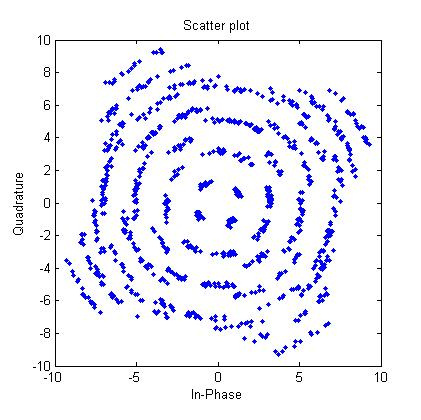
We see how, at a speed of 70 km / h, the points shifted and blocked the zones of each other, which immediately markedly increases the number of errors. Fortunately, OFDM modulation is additionally applied in the radio channel, which is more tolerant to the Doppler effect.

In OFDM modulation, several signals are transmitted in parallel with a specially selected frequency in such a way that at the frequency of one signal the power of the other signals is zero. The Doppler shift will shift the frequencies of all subcarriers, so there will be interference at the receiver between adjacent subcarriers and the “signal” - “noise” level will decrease. How much? For a frequency of 5.3 GHz at a speed of 253 km / h, the reduction will be 0.1 dB, which is negligible, and a degradation of 1 dB will be observed at a speed of 750 km / h - more serious, but still will not lead to a rupture of the communication channel [2].
To combat the spreading of subcarriers in OFDM, a previously known high amplitude sequence is transmitted at specially allocated frequencies, modulated by a simple and reliable BPSK algorithm.
The receiver can easily detect them, see how much the phase and frequency of these special signals have shifted, and from these data move everything back.

Take a look at other studies of this issue. Pierpaolo Bergamo, Daniela Maniezzo and Kung Yao from the University of California conducted an experiment on the desert road, speeding two cars towards each other at a total speed of up to 240 km / h and demonstrated that the number of packet errors and the delay were close to zero [4].
Similar results were also obtained by Hassan GHANNOUM, David SANZ, Bernadette VILLEFORCEIX, Henri PHILIPPE and Pascal MERCIER from France, when they conducted this experiment by installing base stations on towers along the railroad track, which at a speed of 300 km / h traveled by train [five].


The jumps in the data transfer rate were due to the fact that at these moments the train passed the first and then the second base stations (BS), and the connection was lost for the period of reconnection.
After all theoretical research, three series of experiments were carried out. They were aimed at checking the stability of the communication channel
on Infinet R5000-Smn, 5 GHz equipment, with a 40 MHz bandwidth, 25dBm amplifier power in various scenarios.

The experiments were conducted on a section of the Yekaterinburg ring road under construction, with the following coordinates and terrain profile:


Three series of experiments were performed:
1. In the first series, a 23 dBi base station antenna was mounted on a tripod. Another device was installed in a vehicle that used two omni-directional antennas with a gain of 4 dBi.
Conducted 4 experiments at speeds of 100, 130, 150 and 170 km / h and one experiment at a speed of 170 km / h under the condition of a constant bitrate equal to 90 MB / s. Unidirectional traffic was generated by means of the Berkut device in the direction from the vehicle to the BS. Mode TDMA-MISO. The removal of statistical data occurred from the base station.


The signal level graphs at various speeds show us that the increase in speed has no effect in this range. For the reasons outlined above, channel capacity graphics will be given only for 150 and 170 km / h.
1) 150 km / h, downlink

2) 170 km / h, downlink
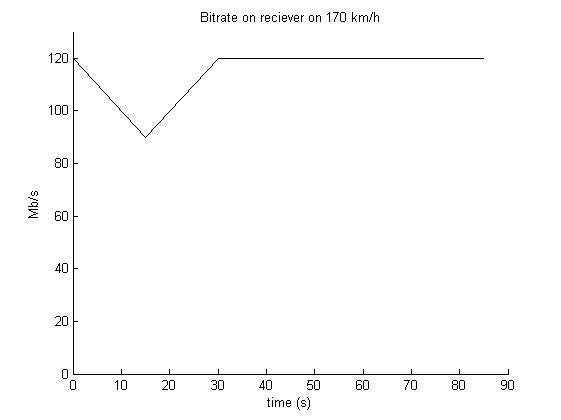
These graphs show us the bandwidth spread by no more than one step (90-135 Mb / s), which tells us that the connection is more than stable.
2. In the second series of experiments, the effect of acceleration on the communication channel was studied. The traffic was also driven unidirectionally by means of the Golden Eagle from the car to the BS. The data acquisition took place in the car: I sat in the passenger seat with a laptop and looked at the graphics.
Two experiments were conducted to test high acceleration at short range and variable acceleration-deceleration at long. Due to the fact that no strong deviations from the normal operation mode have been identified, I will give only the throughput graphs on the transmission side:
2.1 High acceleration, Uplink

The fall at the end occurred due to the fact that at this moment a car with omnidirectional antennas drove past a fixed, stationary antenna and went beyond its coverage area.
2.2 Acceleration-deceleration, Uplink
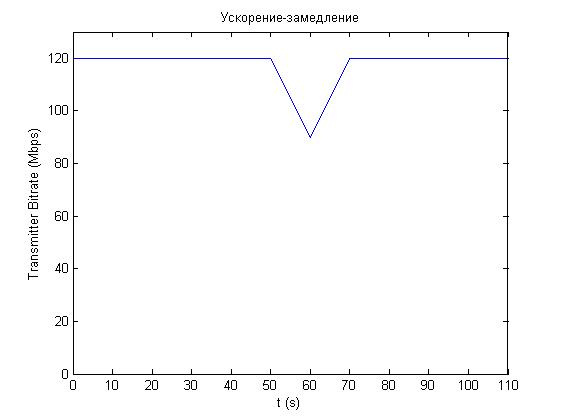
These graphs show us that the effect of acceleration, if any, is very insignificant.
3. In the third series of experiments, two cars were used, and the cars moved towards each other in opposite lanes with a concrete partition between them. On both cars, fins were used as antennas, so in these experiments the power of our channel was lower by 19 dB, and the quality of communication decreased noticeably. For the reference in the first run, the cars moved at a speed of 85 km / h (a total of 170 km / h), so that we could compare the results with previous experiments.
3.1 170 km / h, Uplink
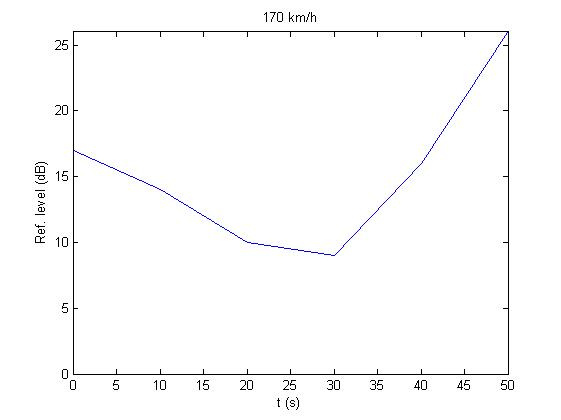
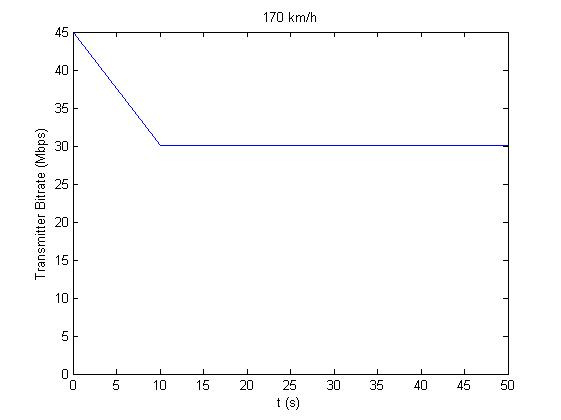
This experiment shows that there is a drop in power, but the spread of data transmission speeds is not critical, which confirms the correlation of this experiment with the previous ones.
3.2 movement of two cars towards each other at a speed of 170 km / h (total = 340 km / h), Uplink
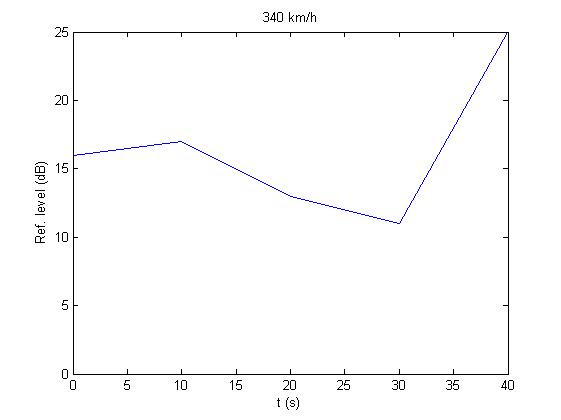

This experiment also shows that its characteristics do not differ from the previous one, which means that devices can operate at these speeds.
The characteristics of the radio communication channel at different speeds of movement up to 340 km / h and in the static link are the same both qualitatively and quantitatively. We could not fix any effect of speed or acceleration on the radio channel in this speed range.
Thank you for being with us)
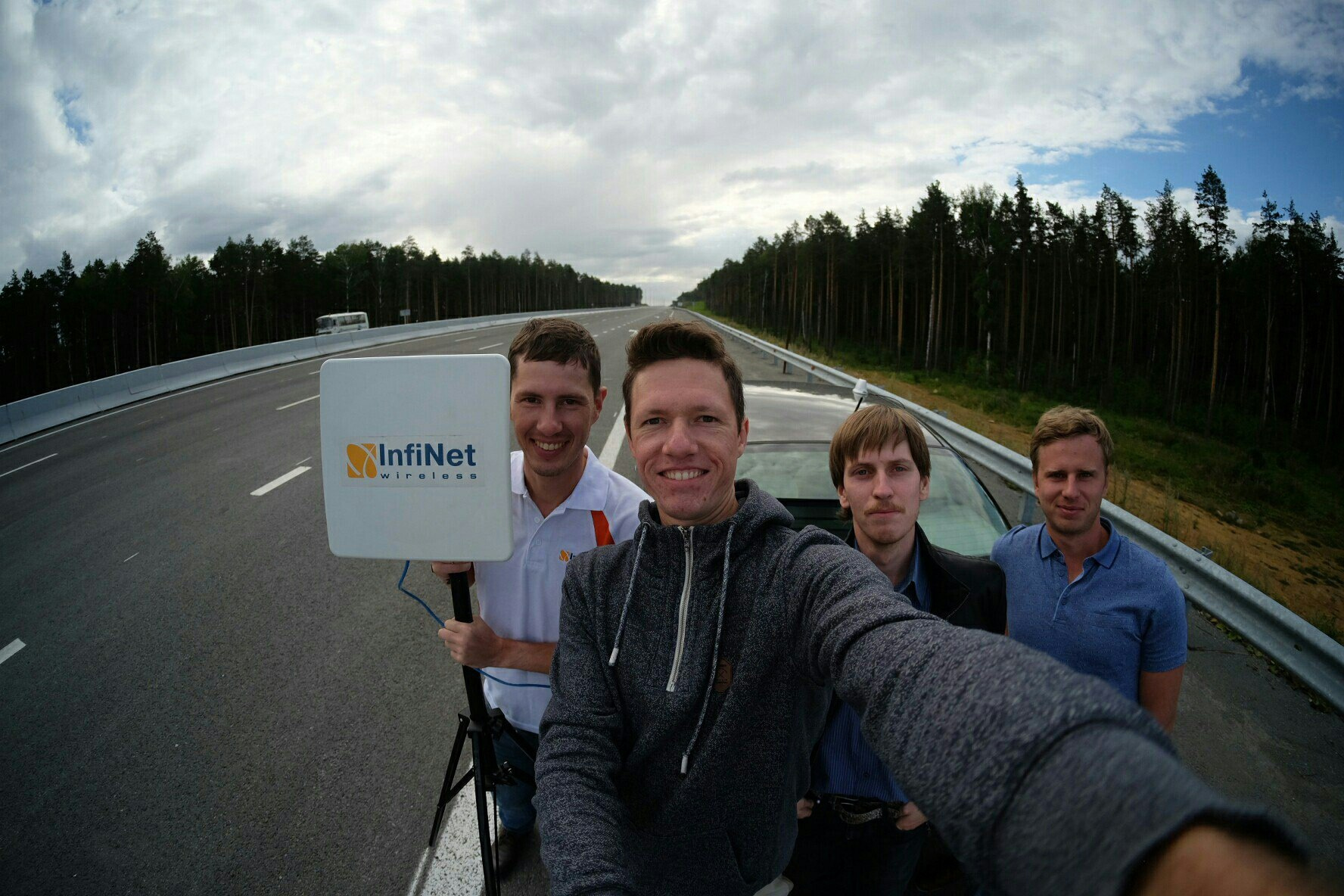

My name is Ilya Shukhman, and more recently I was a student at the Ural Federal University of the Institute of Radio Electronics and Information Technology (IRIT-RTF). My specialization - on papers radio engineer, in fact - there was a bit of STM-32 programming, there was project planning, there was also a radio communication system simulation, I was interested in Cisco equipment. After the end of training days, I went to practice at InfiNet Wireless.
I was instructed to prepare an experiment that would dispel doubts about the possibility of using this company's radio equipment on links, where the subscriber is moving relative to the base station at high speed. For example, if it is attached to the Sapsan locomotive. One of the threats in this case is the Doppler effect, in which the frequency of the wave changes with the relative movement of the transmitter and receiver.
Doppler effect
What is the nature of this effect? Imagine that you were given a roll of paper and charged to draw a sine wave on it. You started the task responsibly, but in the process, the paper on which you are drawing began to move with some speed. Obviously, if you pretend like nothing happened, the wavelength in your pattern will increase, and the frequency will decrease. This effect is called the Doppler frequency shift.
In a narrowband signal, the Doppler shift is represented by the following formula [1]:
Where - carrier frequency signal - relative speed of movement, - the speed of light.
For example, let's take parameters close to our equipment and condition of the problem: speed - 300 km / h, carrier frequency - 5.3 GHz, speed of light - as always 3 * 10 ^ 8 m / s.
Calculate:
$$ display $$ f_d = 5.3 \ cdot 10 ^ 9 Hz \ cdot \ frac {300 \ frac {km} {h}} {3 \ cdot 10 ^ 8 \ fracms} = 5.3 \ cdot 10 ^ 9 Hz \ cdot \ frac {300 \ fracms} {3.6 \ cdot 3 \ cdot 10 ^ 8 \ fracms} = 1472 \ Hz≈1.5 \ kHz $$ display $$
For data transmission to the radio, QAM modulation can be used, in which information is encoded on the basis of constellations. The more points in the constellation, the higher the bandwidth of the radio channel. In Matlab, we model the usual transmission over the radio path, using the Rice channel as a model:

Let me remind you that each cluster of points corresponds to one byte. Yes, the points have a little spread, but within the limits of decency, and the receiver can still unequivocally understand which byte each point corresponds to. Now let's add the Doppler shift at a speed of 30 km / h:

At 70 km / h:

At 100 km / h:

We see how, at a speed of 70 km / h, the points shifted and blocked the zones of each other, which immediately markedly increases the number of errors. Fortunately, OFDM modulation is additionally applied in the radio channel, which is more tolerant to the Doppler effect.

In OFDM modulation, several signals are transmitted in parallel with a specially selected frequency in such a way that at the frequency of one signal the power of the other signals is zero. The Doppler shift will shift the frequencies of all subcarriers, so there will be interference at the receiver between adjacent subcarriers and the “signal” - “noise” level will decrease. How much? For a frequency of 5.3 GHz at a speed of 253 km / h, the reduction will be 0.1 dB, which is negligible, and a degradation of 1 dB will be observed at a speed of 750 km / h - more serious, but still will not lead to a rupture of the communication channel [2].
To combat the spreading of subcarriers in OFDM, a previously known high amplitude sequence is transmitted at specially allocated frequencies, modulated by a simple and reliable BPSK algorithm.
The receiver can easily detect them, see how much the phase and frequency of these special signals have shifted, and from these data move everything back.
Similar work
Take a look at other studies of this issue. Pierpaolo Bergamo, Daniela Maniezzo and Kung Yao from the University of California conducted an experiment on the desert road, speeding two cars towards each other at a total speed of up to 240 km / h and demonstrated that the number of packet errors and the delay were close to zero [4].
Similar results were also obtained by Hassan GHANNOUM, David SANZ, Bernadette VILLEFORCEIX, Henri PHILIPPE and Pascal MERCIER from France, when they conducted this experiment by installing base stations on towers along the railroad track, which at a speed of 300 km / h traveled by train [five].
The jumps in the data transfer rate were due to the fact that at these moments the train passed the first and then the second base stations (BS), and the connection was lost for the period of reconnection.
Experiment
After all theoretical research, three series of experiments were carried out. They were aimed at checking the stability of the communication channel
on Infinet R5000-Smn, 5 GHz equipment, with a 40 MHz bandwidth, 25dBm amplifier power in various scenarios.

The experiments were conducted on a section of the Yekaterinburg ring road under construction, with the following coordinates and terrain profile:


Three series of experiments were performed:
1. In the first series, a 23 dBi base station antenna was mounted on a tripod. Another device was installed in a vehicle that used two omni-directional antennas with a gain of 4 dBi.
Conducted 4 experiments at speeds of 100, 130, 150 and 170 km / h and one experiment at a speed of 170 km / h under the condition of a constant bitrate equal to 90 MB / s. Unidirectional traffic was generated by means of the Berkut device in the direction from the vehicle to the BS. Mode TDMA-MISO. The removal of statistical data occurred from the base station.


The signal level graphs at various speeds show us that the increase in speed has no effect in this range. For the reasons outlined above, channel capacity graphics will be given only for 150 and 170 km / h.
1) 150 km / h, downlink

2) 170 km / h, downlink

These graphs show us the bandwidth spread by no more than one step (90-135 Mb / s), which tells us that the connection is more than stable.
2. In the second series of experiments, the effect of acceleration on the communication channel was studied. The traffic was also driven unidirectionally by means of the Golden Eagle from the car to the BS. The data acquisition took place in the car: I sat in the passenger seat with a laptop and looked at the graphics.
Two experiments were conducted to test high acceleration at short range and variable acceleration-deceleration at long. Due to the fact that no strong deviations from the normal operation mode have been identified, I will give only the throughput graphs on the transmission side:
2.1 High acceleration, Uplink

The fall at the end occurred due to the fact that at this moment a car with omnidirectional antennas drove past a fixed, stationary antenna and went beyond its coverage area.
2.2 Acceleration-deceleration, Uplink

These graphs show us that the effect of acceleration, if any, is very insignificant.
3. In the third series of experiments, two cars were used, and the cars moved towards each other in opposite lanes with a concrete partition between them. On both cars, fins were used as antennas, so in these experiments the power of our channel was lower by 19 dB, and the quality of communication decreased noticeably. For the reference in the first run, the cars moved at a speed of 85 km / h (a total of 170 km / h), so that we could compare the results with previous experiments.
3.1 170 km / h, Uplink


This experiment shows that there is a drop in power, but the spread of data transmission speeds is not critical, which confirms the correlation of this experiment with the previous ones.
3.2 movement of two cars towards each other at a speed of 170 km / h (total = 340 km / h), Uplink


This experiment also shows that its characteristics do not differ from the previous one, which means that devices can operate at these speeds.
Conclusion
The characteristics of the radio communication channel at different speeds of movement up to 340 km / h and in the static link are the same both qualitatively and quantitatively. We could not fix any effect of speed or acceleration on the radio channel in this speed range.
Thank you for being with us)

Literature
1. ru.wikipedia.org/wiki/Effect_Doplera
2. OFDM for Wireless Multimedia Communications, RiChard van Nee, Ramjee Prasad, Artech House
3. “DEVELOPMENT OF THE METHODS OF CORRECTION OF COMPLEX TRANSFER CHARACTERISTICS IN SYSTEMS WITH ORTHOGONAL FREQUENCY DIVISION OF CHANNELS AND MULTIPLEXING (OFDM)”, Pozdnyakova Lidiya, Vladimir State University.
4. home.deib.polimi.it/cesana/publications/conferences/PDF/BergamoITC2003.pdf
5. www.railway-research.org/IMG/pdf/d3_ghannoum_hassan.pdf
2. OFDM for Wireless Multimedia Communications, RiChard van Nee, Ramjee Prasad, Artech House
3. “DEVELOPMENT OF THE METHODS OF CORRECTION OF COMPLEX TRANSFER CHARACTERISTICS IN SYSTEMS WITH ORTHOGONAL FREQUENCY DIVISION OF CHANNELS AND MULTIPLEXING (OFDM)”, Pozdnyakova Lidiya, Vladimir State University.
4. home.deib.polimi.it/cesana/publications/conferences/PDF/BergamoITC2003.pdf
5. www.railway-research.org/IMG/pdf/d3_ghannoum_hassan.pdf
All Articles